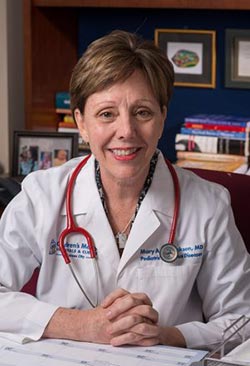Cases of acute flaccid myelitis, which mainly affects children and can cause lasting paralysis, continue to be reported this fall across the U.S. When two possible cases of the polio-like disease were reported in Kansas City, people looking for answers turned to Mary Anne Jackson, M.D. ’78, interim dean of the University of Missouri-Kansas City School of Medicine.
Jackson is an expert in pediatric infectious diseases section at Children’s Mercy in Kansas City. She has been offering parents reassurance and colleagues advice.
Stats

The disease is extremely rare, Jackson said, with one-in-a-million odds of contracting it. So parents shouldn’t be alarmed, she said, even though reports of the disease, often referred to as AFM, have been occurring in two-year cycles since 2014.
Jackson said AFM, which appears to develop after a viral illness, could have several possible causes. Enterovirus D68 has been getting attention as a possibility, because respiratory problems from EV-D68 were widespread in 2014 when 120 cases of AFM were reported. The number dropped to 22 AFM cases in 2015 and spiked again, to 149, in 2016. The pattern continued with just 38 cases in 2017 but 80 confirmed so far this year by the Centers for Disease Control, out of 219 possible cases reported. The AFM numbers coincide with the cycles of viruses such as EV-D68, which tend to rise every other autumn.
Symptoms
Jackson said symptoms are easy to recognize because AFM attacks regions of the spinal cord known as gray matter.
“If your child develops profound weakness, especially involving limbs, make sure to see your physician,” she said.
Jackson also recently prepared an update on the disease for physicians. Besides acute limb weakness, Jackson said, a review of AFM reports also found signs of cranial nerve involvement, such as facial weakness, in more than one-fourth of cases. She said that examining cerebrospinal fluid and doing an MRI of the brain and spine were key to diagnosing AFM, and that all cases should be reported to the CDC.
Prevention
As for prevention, she said, nothing has been identified beyond the usual emphasis on hand washing and
covering coughs to disrupt any viral illness that could be related. Though most AFM patients survive, weakness and paralysis can persist. Jackson said nerve transfer surgery – at Children’s Hospital Los Angeles, Washington University in St. Louis and Shriners Hospital for Children in Philadelphia – showed some promise in cases of isolated limb disease. One Washington University patient, an 8-year-old boy whose legs were paralyzed in 2016, recently started walking again after the nerve transfer surgery.
Besides keeping good track of cases the rest of this fall, Jackson said, “We will have to stay tuned to see how effective new research is in uncovering the etiology of this disease.”
